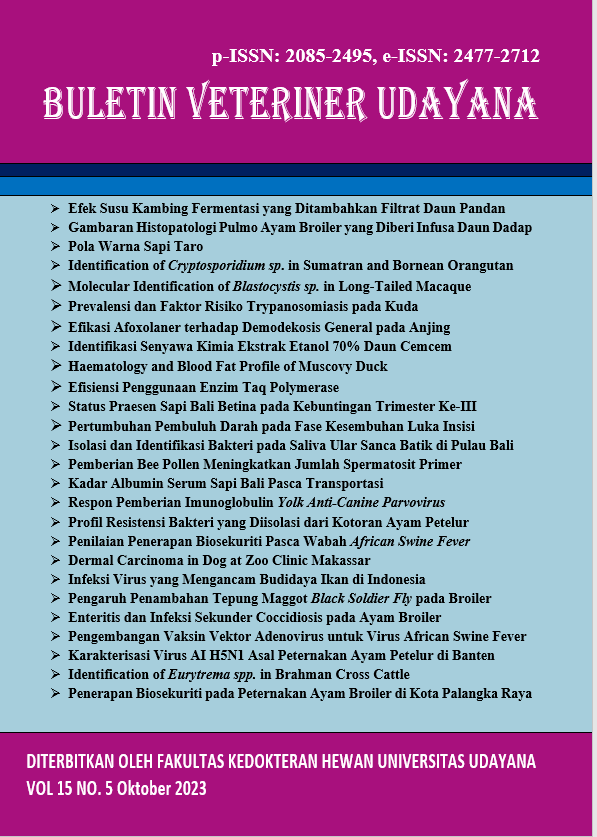IDENTIFICATION OF CRYPTOSPORIDIUM SP. IN SUMATRAN ORANGUTAN AND BORNEAN ORANGUTAN AT NORTH SUMATERA WILDLIFE PARK
Abstract
Cryptosporidium sp. is a zoonotic intestinal protozoa in orangutans which is transmitted through contaminated water (waterborne disease). This study aims to determine Cryptosporidium sp. which infects the sumatran orangutan (Pongo abelii) and the bornean orangutan (Pongo pygmaeus) in North Sumatera Wildlife Park. The samples used were 3 orangutan fecal samples from different locations, two bornean orangutans in Medan Wildlife Park and one sumatran orangutan in Pematang Siantar Animal Park. Samples were examined using the floatation method and the modified Ziehl-Neelsen method. The results showed that from 3 samples of orangutan feces (sumatran and bornean orangutan), 2 positive tails from bornean orangutans were found containing Cryptosporidium oocysts, namely the C. parvum species. In this study, it can be concluded that the orangutans in Medan Wildlife Park, the bornean orangutan were infected with cryptosporidiosis.
Downloads
References
Chua L, Harrison ME, Fair H, Milne S, Palmer A, Rubis J, Thung P, Wich S, Büscher B, Cheyne SM, Puri RK, Schreer V, Stępień A, Meijaard E. 2020. Conservation and the social sciences: beyond critique and cooptation. People Nat. 2(1): 42-60.
Cibot M, McLennan MR, Kváč M, Sak B, Asiimwe C, Petrželková K. 2021. Sparse evidence for Giardia intestinalis, Cryptosporidium spp. and Microsporidia infections in humans, domesticated animals and wild nonhuman primates sharing a farm–forest mosaic landscape in Western Uganda. Pathogens. 10(8): 1-11.
Condro AA, Prasetyo LB, Rushayati SB, Santikayasa IP, Iskandar E. 2021. Redistribution of sumatran orangutan in the Leuser ecosystem due to dispersal constraints and climate change. IOP Conf. Series: Earth Environ. Sci. 771(1): 1-14.
Fayer R. 2004. Cryptosporidium: a water-borne zoonotic parasite. Vet. Parasitol. 126(1-2): 37-56.
Khan A, Shaik JS, Grigg ME. 2018. Genomics and molecular epidemiology of Cryptosporidium species. Acta Trop. 184(1): 1-14.
Kusumasari RA, Syairaji M. 2020. Uji validitas dan efikasi crypto/giardia duo strip dalam mendeteksi Cryptosporidium spp. di Desa Tulehu, Kabupaten Maluku Tengah, Provinsi Maluku. J. Kes. Vokasional. 5(3): 189-195.
Mahardianti M, Kurniawan A, Sari IP. 2020. Potential transmission of Cryptosporidium sp. in Ciliwung river water, Jakarta. eJ. Ked. Indon. 8(2): 131- 136.
Maryanti E, Rahmi H, Lesmana SD, Haslinda L. 2014. Deteksi Cryptosporidium sp. dengan pewarnaan modifikasi tahan asam pada tinja siswa SDN X Kecamatan Rumbai, Pekanbaru. J. Ilmu Ked. 8(1): 25-28.
Maryanti E. 2017. Epidemiologi kriptosporidiosis. J. Ilmu Ked. 5(1): 1-6.
Menu E, Davoust B, Mediannikov O, Akiana J, Mulot B, Diatta G, Levasseur A, Ranque S, Raoult D, Bittar F. 2021. Occurrence of ten protozoan enteric pathogens in three non-human primate populations. Pathogens. 10(3): 1-10.
Mehlhorn H. 2012. Animal parasites diagnosis, treatment, prevention. Switzerland. Springer.
Mohammed A, Degefu H, Jilo K. 2017. Cryptosporidium and its public health importance. Int. J. Res. Stu. Microbiol. Biotech. 3(4): 12-31.
Mufa RMD, Lastuti NDR, Rantam FA, Suwanti LT, Suprihati E, Handijatno D. 2020. Deteksi Cryptosporidium canis pada anjing di Kota Surabaya. J. Vet. 21(2): 176-182.
Mynářová A, Foitová I, Kváč M, Květoňová D, Rost M, Morrogh-Bernard H, Nurcahyo W, Nguyen C, Supriyadi, Sak B. 2016. Prevalence of Cryptosporidium spp., Enterocytozoon bieneusi, Encephalitozoon spp. and Giardia intestinalis in wild, semi-wild and captive orangutans (Pongo abelii and Pongo pygmaeus) on Sumatra and Borneo, Indonesia. PLoS One. 11(3): 1-15.
Osman M, El-Safadi D, Cian A, Benamrouz S, Nourrisson C, Poirier P, Pereira B, Razakandrainibe R, Pinon A, Lambert C, Wawrzyniak I, Dabboussi F, Delbac F, Favennec L, Hamze M, Viscogliosi E, Certad G. 2016. Prevalence and risk factors for intestinal protozoan infections with Cryptosporidium, Giardia, Blastocystis and Dientamoeba among schoolchildren in Tripoli, Lebanon. PLoS. Negl. Trop. Dis. 10(4): 1-17.
Prasetyo RH. 2012. The intestinal cryptosporidiosis in HIV/AIDS patients who have homosexual behaviour. Folia Med. Indon. 48(2): 75-76.
Rachmawati I. 2019. Analisis hubungan higiene perorangan dengan kejadian toksoplasmosis pada komunitas pemelihara kucing “bungkul cat lovers” di Surabaya. J. Kes. Ling. 11(2): 116-122.
Tamba RN, Prana RR. 2020. Pengaruh pelayanan terhadap peningkatan kunjungan wisatawan pada Taman Margasatwa Medan. J. Stud. Manajemen. 2(1): 51-57.
Tarigan K, Nurmawan W, Langi MA. 2021. Analisis perilaku harian harimau sumatera (Panthera tigris sumatrae) di Taman Margasatwa Medan. COCOS. 5(5): 1-22.
Taylor MA, Coop RL, Wall RL. 2016. Veterinary parasitology. British. Library of Congress Cataloging.
Wahdini S, Putra VP, Sungkar S. 2021. The prevalence of intestinal protozoan infections among children in Southwest Sumba based on the type of water sources. Infect. Chemother. 53(3): 519- 527.
Wijayanti T. 2017. Kriptosporidiosis di Indonesia. Balaba: J. Litbang Pengendalian Penyakit Bersumber Binatang Banjarnegara. 13(1): 73-82.
Xiao L, Feng Y. 2008. Zoonotic cryptosporidiosis. FEMS Immunol. Med. Microbiol. 52(3): 309-323.
Zhao W, Zhou H, Jin H, Liu M, Qiu M, Li L, Yin F, Chan JFW, Lu G. 2019. Molecular prevalence and subtyping of Cryptosporidium hominis among captive long-tailed macaques (Macaca fascicularis) and rhesus macaques (Macaca mulatta) from Hainan Island, Southern China. Parasites Vectors 12(1): 1-7.





